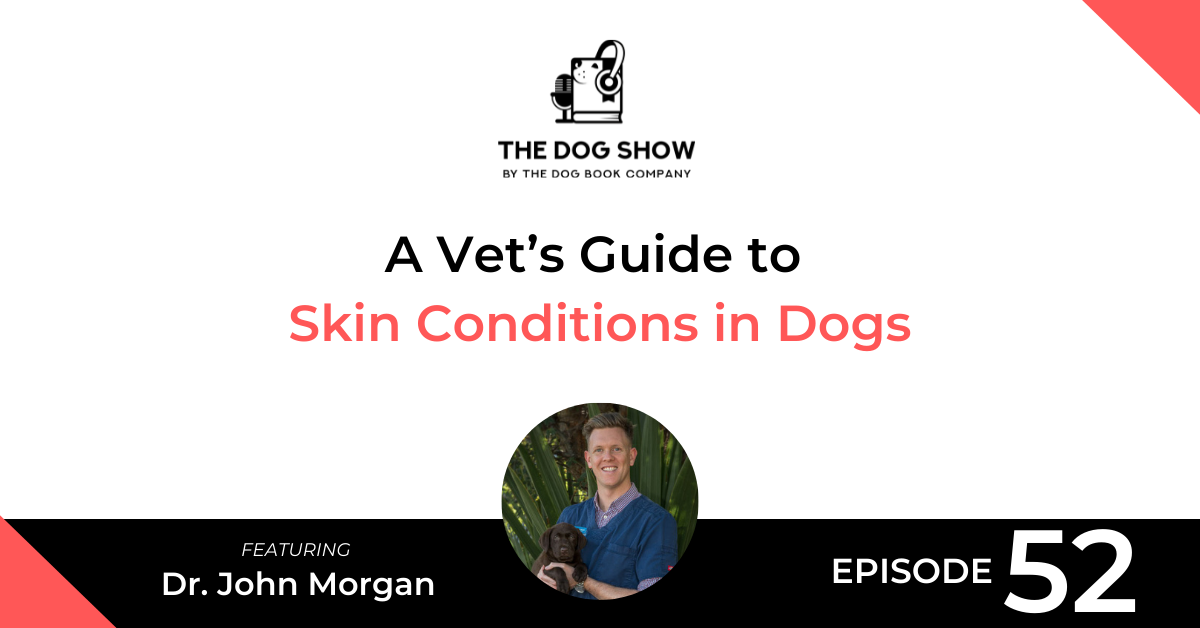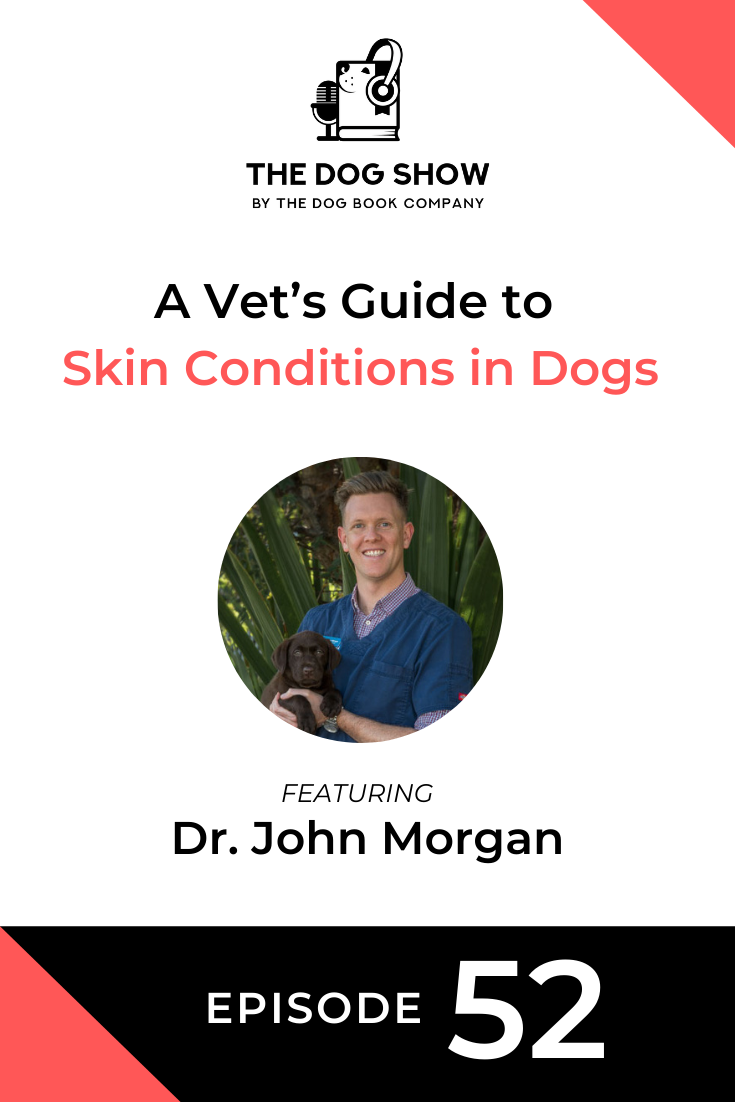
Does your dog have a skin condition?
In this episode of The Dog Show, featuring Dr. John Morgan, we discuss skin conditions in dogs; including how to know if your dog has a skin condition and how to treat it if they do.
John is a Partner Veterinarian at Gordon Vet Hospital, an independently owned vet practice that has been operating since 1971.
Find out more about Gordon Vet Hospital here:
Listen
Watch
Read
Will: This episode of “The Dog Show” features Dr. John Morgan, who has been on the show numerous times now. John is a partner veterinarian at Gordon Vet Hospital where he specializes in orthopedic conditions and arthritis in dogs. But in today’s episode, we’re discussing skin conditions in dogs, including how to know if your dog has a skin condition and how to treat it if they do. John, welcome to the dog show again. Thanks for coming on.
John: Thanks for having me, Will.
Will: So, today we’re going to talk about skin conditions and dermatology. It’s probably a common thing a lot of dog owners are dealing with. I’ve dealt with it myself with my dog. But, what are some common skin conditions that you’d see others come in with, well, for their dogs.
John: Yeah. Yeah, not the owners hopefully. I guess, dogs probably are, the main thing we see is more of a seasonal allergy. So, it’s probably the most common issue and definitely we’re in summer in Australia at the moment. It is what we’re seeing the most out of all conditions. We do see a lot of really itchy dogs and quite a lot of hair loss and skin thickening. And then, beyond that, obviously fleas do become an issue for dogs that aren’t on prevention. But fortunately, dog flea prevention has really, really advanced in the last few years, so I’m not seeing as much of that anymore. And, that also excluded other parasitic skin diseases, like, Demodex mites or even sarcoptic mites which affect the ears and face of dogs.
Will: Okay. So, they’re caused by, I guess, other, like, mites and things like that, right?
John: Yeah.
Will: Those type, and then you’ve got the allergies which are caused by genetics or…
John: Yeah. So, allergies are very much, yeah, genetic-based, so there are certain breeds, unfortunately French Bulldogs [00:01:57] Labradors, German Shepherds, and definitely we do see a lot in West Highland White Terriers, probably the highest rate of skin issues in Westies.
Will: Right.
John: But, yeah. Their genetics are weighing in to their condition, but there’s also a lot of external factors. So, interestingly, the food can be a big factor in skin allergies, as can, sort of, plants, plant pollens, grasses and even insects in the environment that aren’t parasites such as dust mites and what’s called a food storage mite can cause allergies, are some examples.
Will: Okay. So, and you mentioned that the hotter months are when these things rear their head a little bit more?
John: Yeah, yeah. And it’s often to do with more the pollen counts and sort of the activity of the dogs. You know, obviously, moisture content of the air and swimming are big factors in skin conditions, because we often do have an underlying allergy, so the dogs react, they scratch and damage the skin, and that actually opens it up to a secondary infection. So, we’re not only seeing allergies that we know them, which is a little bit of itchy skin. We often get a secondary bacterial or yeast infection that your vet needs to diagnose and treat very differently.
Will: So, yeah. So, how are, I guess, allergies or skin conditions showing up on the dog? You’re talking about, you mentioned potentially bacterial infections and scratching and, you know, redness. Are they the main ones?
John: Yeah. I think that, so scratching’s probably the earliest sign. Redness I find is only really picked up in, on the belly and in the armpits. So, it’s sort of, you might be missing the signs if you look for redness. Scratching is definitely the biggest one to look for. And the one that often is missed or that I find that you have to sort of ask more questions about is ear infections, and obviously ears are part of the skin. They are a really confined tube of skin essentially, and they’re really, really sensitive to allergies and, obviously, skin infections.
Will: Yeah.
John: So, a lot of dogs will come in and they’ll be, you know, have really bad ear infections but owners just think they’ve been scratching their collar because they’re quite close to their ears. So, that’s one big one that we’re always asking owners to keep an eye out for is definitely the scratching of the ears.
Will: Yeah. I’ve had experience there myself, and it’s really easy, as you said, to overlook some things.
John: Yeah.
Will: You may not necessarily see them scratching or you may not have a look and then it can get, it can really build up and get out of control before you even know it.
John: Exactly. And I can 100% empathize because, you know, obviously, you know, you don’t know what an ear infection would look like. You don’t see this every day and this is your beloved pet, Frankie, who has developed these signs out of nowhere and, you know, you don’t know what an ear infection would look like. So, I don’t blame you for seeing that for sure.
Will: Well, I guess as a French Bulldog owner, there’s some slight difference. Because the ears are so exposed, we are now encouraged by our vet to kind of clean them regularly, right?
John: Yep.
Will: Which, is one thing that does help with that. But, I guess not all dogs, the dogs that have the ears which, kind of, are covered, you’re probably less exposed to external, you know, dander and things like that.
John: Yeah. Well, it can go both ways. So, I mean, obviously Frankie’s ears straight up as a French Bulldog’s are. The trend towards Labradoodles and Cavoodles, they often have flopped over ears, or beagles. That’s another good example. That flap actually traps in a lot of moisture, and that moisture actually contributes to a lot of yeast ear infections in those dogs. So, cleaning can actually be very beneficial. But the caveat to that is unfortunately flushing can be quite painful or even lead to resistance issues. So, if we’re flushing on top of an active infection without getting veterinary advice, that can actually make things a lot worse. So, flushing is definitely a good preventative in early cases, but if it’s not making a difference, please, please, please consult your vet.
Will: Another thing I’ve noticed as a warning sign to be aware of is the smell.
John: Yeah.
Will: So, I mean, yes, you can smell it yourself if you’re near your dog, but also, like, when you’re walking, if another dog goes up and smells the ear straight away, you know something’s going on in there.
John: Big time, yeah. And, I mean, some vets will, you know, make an initial diagnosis on the smell alone. So, it’s not uncommon for them to, you know, the vets to lift up the ear, have a sniff and go, yeast infection or, you know, pseudomonas is a common bacteria that has a very distinct almost sweet smell. But those kind of changes are definitely ones that you want to get the vet involved in, because despite the fact that they don’t seem too uncomfortable in most cases, it can be really painful and uncomfortable for them.
Will: Okay. So, you spoke briefly about kind of the causes of, you know, the allergies, for example, like danders and pollens and maybe food, for example. How do you find out what’s actually causing it? I imagine that’s pretty hard process.
John: Yeah. Yeah. So, I mean, we’re, at Gordon Vets we’re not a specialist clinic, and we do often have to refer to specialists on really difficult skin conditions. But from our perspective, we often do blood testing. Interestingly, there’s a there’s a lab test that actually pinpoints what exactly dogs are allergic to, and it does help us with not only eliminating that from the environment, but we’ve now been able to formulate what’s called a desensitization injection. So, we can actually put together an injection that reduces sensitivity to certain pollens or certain insects that might be causing allergies.
Will: And that’s a permanent kind of one-time thing or do you have to have that regularly or?
John: Yeah. So, it generally is long term, so I find that most dogs are sort of on it, but it’s a reducing dose. So, they’ll get very frequent, I think it’s weekly injections initially and it often reduces to once a month or once every six weeks. And, they’re put together in batches and you basically administer them at home in most cases.
Will: Is that blood test, is it common for dogs to be allergic to multiple things?
John: Almost always.
Will: Okay.
John: Good question. So, yeah. I find them, they’re useful in cases where we do want to really dig deep and find out what’s going on. But, my personal experience is that dogs are allergic to everything. So, we often have to pinpoint, not just pinpoint, but also just treat more holistically. We do put them on drugs to reduce their body’s sensitivities to those allergens, and sometimes we do have to use techniques to avoid those. So, obviously if we have a flea allergy, very simple to fix these days. If we have a storage mite allergy, we just freeze the dry food so we’re not getting as many storage mites or we avoid the dog park where these certain trees are to try and stop those contact allergies or more of an environmental allergy taking hold.
Will: Yeah. The environmental ones are the hardest ones to avoid, right? I mean, if it’s something in the food, you can, kind of, eliminate that quite easily.
John: Yeah.
Will: But, yeah, the environmental ones, like, who knows where certain pollens are and, yeah.
John: Exactly, yeah. And unless you want to sort of keep him in a bubble at all times, it can be really difficult to eliminate. So, I’m always wary of using those results solely. Because, that we get so many positives and we don’t know what that means, we do have to sort of try different techniques to manage skin. And it is, in my experience, it’s probably one of the areas that’s most frustrating for owners, and I totally get that, because we often do so many different treatments and so many revisits, but from the vet’s perspective it’s because, you know, it is a little bit of trial and error to try and work out what’s going to work without too many side effects of medications.
Will: Yeah. It’s definitely a challenge. So, I mean, what are the earliest warning signs of maybe an allergy or another skin condition that I can be looking out for? Because, I know from experience, like, you might think, “Oh, that’s a little scratch or, you know, they’re licking their paw that day and it’s not a big deal.
John: Yeah.
Will: But sometimes, you know, it really builds up without you knowing.
John: Yeah. So, I think the biggest early warning sign I’ve seen in my experience is this, probably the ear scratching, and then the paws seem to be particularly sensitive to allergies. So, if there’s a lot a lot of chewing of the paws, we’d be concerned that there is more of a full body reaction going on.
Will: Yeah.
John: It’s just the small vessels and the exposure of the feet to allergens that seems to be where it comes in first. So, if you’re noticing either of those two areas receiving a lot more attention than the rest of the body, it may be a red flag that we need to get a vet involved.
Will: So, would you go straight to that blood test if I came in and my dog was showing signs of skin conditions or allergies, or would you do something else before that?
John: No. So, most, I mean, most cases are seasonal. So, we’re fortunate that there’s a really, sort of, focused season where we have allergies as opposed to, obviously, in more tropical areas where skin allergies from environmental causes can be year round. So, depending on the climate, we’ll often more just treat the symptoms, manage those and then we’ll revisit with blood testing or even potentially referral if it becomes a repeat issue. Remember that some of these dogs are scratching year round and have permanent skin changes like thickening or increased pigment in the skin, which actually is a sign of more chronic skin disease.
Will: Okay. Okay. So, I guess if I was to summarize the advice on skin conditions or allergies, is just to become aware of maybe what is causing them. So, if you see any signs early on, get to your vet and get a process in place to try and look into it.
John: Yeah, exactly. And do your research, obviously, you know, look at what’s common in the area and make sure even if it’s just a routine checkup, mention it to your vet because, you know, we often do, we don’t get involved in certain areas of the body, or if we don’t hear about it we’re not going to necessarily see evidence of itching or scratching in the exam. So make sure you’re just frank with the vet, they can look at the signs and talk to you about what the options are.
Will: Are there any long-term, kind of, side effects or, you know, bad conditions that can result from skin conditions? So, for example, the ear infection, you have an exam, would that result in loss of hearing or something like that?
John: Definitely, yeah. And, you know, otitis media which is the extension of otitis externa, or it can progress to basically, that’s a middle ear infection. If we let ear infections go for too long, can actually really affect dogs balance. And, yeah, if it extends then to otitis interna or an inner ear infection, they can lose hearing. So, it’s important not just to neglect it or to leave it alone. Essentially, we do want to talk to a vet and potentially get that treated.
Will: Great. So, we mainly talked about allergies today, but I think there’s probably a lot of people out there especially in the warmer months dealing with, you know, skin allergies and irritations with their dogs. So, thanks a lot for sharing your expertise in that, John.
John: No worries, Will. Thanks for having me in.
Will: Cheers.
From Our Store
-
French Bulldog Coffee Table Book – The Book of Frenchies
From: AUD $59.99 Add to cart -
Dachshund Coffee Table Book – The Book of Dachshunds
From: AUD $59.99 Add to cart -
Pug Coffee Table Book – The Book of Pugs
AUD $59.99 Add to cart -
French Bulldog Notebook – A5, Hardcover, PU Leather, 100gsm Lined Pages, Bookmark (Three Colours)
AUD $34.99 Select options -
Dachshund Notebook – A5, Hardcover, PU Leather, 100gsm Lined Pages, Bookmark (Three Colours)
AUD $34.99 Select options -
Pug Notebook – A5, Hardcover, Black PU Leather, 100gsm Lined Pages, Bookmark (Three Colours)
AUD $34.99 Select options -
French Bulldog Planner – PU Leather Exterior, Metal Loose Leaf Ring Binder, 100gsm Paper (Two Colours)
AUD $64.99 Select options -
Corgi Notebook – A5, Hardcover, Black PU Leather, 100gsm Lined Pages, Bookmark (Three Colours)
AUD $34.99 Select options -
Dachshund Planner – PU Leather Exterior, Metal Loose Leaf Ring Binder, 100gsm Paper (Two Colours)
AUD $64.99 Select options -
Vizsla/Weimaraner Notebook – A5, Hardcover, PU Leather, 100gsm Lined Pages, Bookmark (Three Colours)
AUD $34.99 Select options -
Cavoodle Notebook – A5, Hardcover, Black PU Leather, 100gsm Lined Pages, Bookmark (Three Colours)
AUD $34.99 Select options -
Beagle Notebook – A5, Hardcover, PU Leather, 100gsm Lined Pages, Bookmark (Three Colours)
AUD $34.99 Select options













